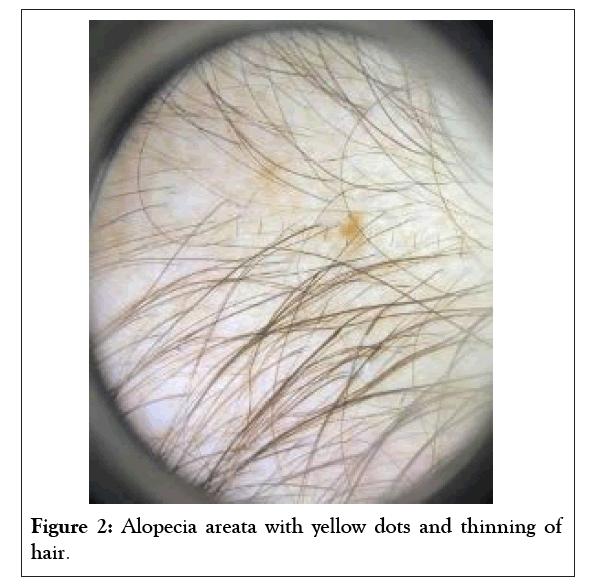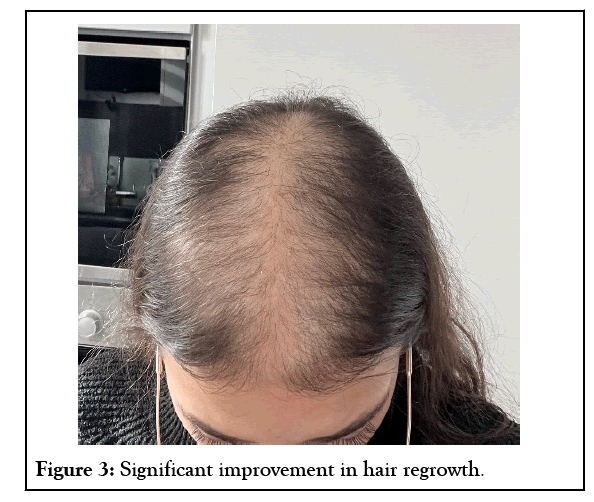Hair Therapy & Transplantation
Open Access
ISSN: 2167-0951
ISSN: 2167-0951
Case Report - (2023)Volume 13, Issue 3
Since its introduction, mesotherapy has become a common technique of administering antiandrogens for the treatment of alopecia areata. The present discussion focuses on a case study that highlights an instance of hair loss induced by mesotherapy, paradoxically, in a 25-year-old female patient. We present a 25-year-old female patient presented to a dermatologist with the principal concern of severe diffuse alopecia after mesotherapy treatment. The patient's past medical history is noteworthy for Raynaud's phenomenon, which manifested when she was four years old. In conclusion, our case study alerted us on the patients of alopecia areata induced by mesotherapy. Mesotherapy was not indicated in a case of progressive alopecia areata or a case with a history of alopecia areata on autoimmune disease.
Alopecia areata; Hair loss; Mesotherapy; Potential treatment; Female patient
In today's world, hair loss has emerged as a pervasive issue afflicting individuals across various age groups and ethnicities. A multitude of factors, including environmental, psychological, genetic and pathological elements, have been implicated in the etiology of hair loss [1]. Mesotherapy, a non-surgical and minimally invasive approach to drug delivery, has gained considerable attention as a potential treatment for this condition.
Mesotherapy encompasses a series of intradermal or subcutaneous injections, employing a melange of compounds in minute doses [2]. This therapeutic modality involves administering a concoction of diverse tonics, such as plant extracts, pharmaceutical agents, vitamins, enzymes, hormones, growth factors and other bioactive substances that can potentially ameliorate alopecia [3]. By utilizing this innovative approach, healthcare professionals may address the complex challenge of hair loss in the modern era.
The present discussion focuses on a case study that highlights an instance of hair loss induced by mesotherapy, paradoxically, in a 25-year-old female patient.
A 25-year-old female patient presented to a dermatologist with the principal concern of severe diffuse alopecia after mesotherapy treatment. The patient's past medical history is noteworthy for Raynaud's phenomenon, which manifested when she was four years old. She acknowledges that her menstrual cycles are regular. She has been using the Leeloo contraceptive pill for the past seven years, to which she has developed tolerance and reports no adverse effects. The patient denies any drug allergies but discloses an allergic predisposition to pollen and sunlight, necessitating one month of treatment each summer. Furthermore, she claims that her skin is highly sensitive.
Her surgical history reveals that she has not undergone any previous surgeries. There is no history of hair loss in her family. Additionally, she is a non-smoker and non-drinker.
This patient underwent mesotherapy for minimal seasonal hair loss on 17/11/2022 as shown in Figure 1A. The administered mesotherapy regimen comprised a blend of buflomedil, hydrochloride, pyridoxine hydrochloride, pantothenic acid, niacinamide, thiamine hydrochloride and acetylcysteine.
Figure 1: A) Minimal seasonal hair loss; B) Hair loss localized to injection site.
Paradoxically, rather than observing improvement, the patient experienced an abrupt intensification of hair loss commencing on the 05/12/2022 and persisting until the 26/12/2022. However, she contends that the hair loss following the treatment was markedly abnormal. The patient reported experiencing pronounced pain in scalp regions following the mesotherapy procedure, a sensation which persisted for a duration of one week. Subsequently, she noticed a lump on her forehead, accompanied by pain.
The general practitioner had done a series of laboratory tests, including assessment of iron concentrations and evaluation of thyroid function which yielded results within normal parameters.
The patient disclosed hair loss localized to the injection site, specifically the top of her scalp as shown in Figure 1B. Consequently, she was prescribed a regimen of intramuscular injections comprising biotin and bepanthene, 3 times a week for six weeks. The patient noted a subsequent reduction in hair loss, but a minimal hair regrowth. The dermoscopy reveals features consistent with alopecia areata: Yellow dots, thinning of hair, coudabily hairs, irregular diameters and few exclamations mark hair as shown in Figure 2.
The treatment included oral prednisolone 50 mg daily tapered down for two weeks by 10 mg, intralesional injection of triamcinolone acetate (8 mg/ml) injection and daily topical clobetasol propionate with a significant improvement after 6 weeks as shown in Figure 3.

Figure 2: Alopecia areata with yellow dots and thinning of hair.

Figure 3: Significant improvement in hair regrowth.
Alopecia Areata (AA) is an autoimmune non-scarring alopecia affecting the scalp and other areas [4]. Mesotherapy is a minimally invasive procedure employed for both medical and cosmetic purposes, which entails injecting active substances into the dermis and subcutaneous tissue [5]. Acute diffuse alopecias such as telogen effluvium and stress alopecias, androgenetic alopecias and alopecia areata are the forms that mesotherapy can be used with reports of good results [6].
In a case report analogous to the present case documented two instances of paradoxical nonscarring alopecia following mesotherapy using dutasteride [5]. Nevertheless, the authors hypothesized that ethanol, the solvent present in the dutasteridecontaining solution, could potentially induce cell damage and death in the hair follicle, subsequently resulting in hair loss.
Another case report identified hair loss in three patients with androgenetic alopecia after uneventful mesotherapy for up to one year [7]. Observed a significant and visible enhancement in hair density and thickness after administering an adjuvant mesotherapy blend comprising minoxidil, finasteride, biotin and D-Panthenol for 20 sessions [8].
Although topical corticosteroids have demonstrated efficacy in the treatment of AA, intralesional steroids are advocated as the first-line therapy in the United Kingdom, United States and Kingdom of Saudi Arabia [9]. National Guidelines from the British Association of Dermatologists [10], further endorse intralesional corticosteroid therapy as the primary treatment for localized patchy AA, boasting success rates of approximately 60%-75%. We observed a marked enhancement in hair density following the administration of 50 mg prednisolone daily, intralesional injection of triamcinolone acetate (8 mg/ml) and daily topical application of clobetasol propionate.
In contrast documented a case of irreversible alopecia in a patient experiencing delayed hypersensitivity to intralesional triamcinolone injections [11]. Concurrently, a study conducted by Kassim et al. demonstrated hair regrowth subsequent to intralesional triamcinolone administration, with injections repeated biweekly for a total of three instances [12]. Additionally, two separate investigations reported significant hair regrowth in conjunction with intralesional triamcinolone acetonide at the respective injection sites [10-13].
Adverse events associated with intralesional steroid injections, including pain and skin atrophy at the injection sites, have been reported in up to 24% of cases [9]. Nonetheless, our case study revealed no adverse effects experienced by the patient. Intralesional corticosteroid injections, such as triamcinolone, have demonstrated effectiveness in treating alopecia areata, albeit with varying degrees of success. Research suggests that these injections are most efficacious in patients with limited AA and a shorter disease duration. Conversely, patients with extensive AA and a longer disease duration (>1 year) displayed a poor response [12].
However, it is imperative to exercise caution when interpreting the evidence, as the available data is limited by a dearth of studies. Furthermore, the studies are characterized by small sample sizes, susceptibility to bias and distinct treatment regimens for each, rendering the findings of this critically appraised topic inconclusive [12].
In conclusion, our case study alerted us on the patients of alopecia areata induced by mesotherapy. Mesotherapy was not indicated in a case of progressive alopecia areata or a case with a history of alopecia areata on autoimmune disease. However, evidence is limited by small sample sizes, biases and differing regimens. Further research is needed to establish conclusive findings, address research gaps and identify the most effective treatments for different alopecia types.
This work is unique and has never been published before.
This case report does not require ethical review. The participant provided written informed consent for the publication of the information of their medical case and any related photographs.
Contacting the corresponding author will provide you with further information and data about this case.
For this publication, no money was collected.
[CrossRef]
[CrossRef] [Google Scholar] [PubMed]
[CrossRef] [Google Scholar] [PubMed]
[CrossRef] [Google Scholar] [PubMed]
[CrossRef] [Google Scholar] [PubMed]
[CrossRef] [Google Scholar] [PubMed]
[CrossRef] [Google Scholar] [PubMed]
[CrossRef] [Google Scholar] [PubMed]
Citation: Al-Khalaf H, Reygagne P, Baqays A, Alzaid MYM, Assouly P (2023) One Case of Paradoxical Hair Loss-Induced by Mesotherapy. Hair Ther Trasplant. 13:222.
Received: 13-Sep-2023, Manuscript No. HTT-23-26876; Editor assigned: 15-Sep-2023, Pre QC No. HTT-23-26876 (PQ); Reviewed: 02-Oct-2023, QC No. HTT-23-26876; Revised: 09-Oct-2023, Manuscript No. HTT-23-26876 (R); Published: 16-Oct-2023 , DOI: 10.35248/2167-0951.23.13.222
Copyright: © 2023 Al-Khalaf H, et al. This is an open-access article distributed under the terms of the Creative Commons Attribution License, which permits unrestricted use, distribution, and reproduction in any medium, provided the original author and source are credited.